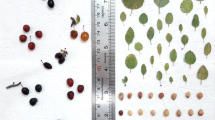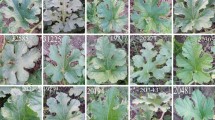Abstract
Iran is one of the most important growing centers for wild and domesticated species and varieties of Prunus subgenus Cerasus plants. Due to the suitable adaptation of wild species to the environmental and edaphic conditions of this country, they can be used as rootstock for sweet and sour cherry cultivars as well as in breeding programs for rootstock improvement, and a program has been initiated for this purpose. As a first step towards exploring the genetic diversity of P. incana Pall., morphological traits were used to evaluate the variation within its population dispersed in East and West Azerbaijan and Kordestan Provinces of Iran. In this study, 32 accessions of P. incana and 3 accessions from related species (Prunus avium L., P. cerasus L., and P. mahaleb L.) were used. Seventeen quantitative and two qualitative traits (vegetative and reproductive) were analyzed, and significant differences among accessions were found for most traits. Results of simple correlation analysis showed significant positive or negative correlations among some important traits such as tree height, leaf area, and leaf blade length and width. Factor analysis showed that leaf area, leaf blade length and width, petiole length, fruit and stone weight, fruit length and diameter, stone volume, and plant height constructed the main factors. Cluster analysis clearly discriminated P. incana accessions from other Prunus species and also differentiated P. incana accessions according to their geographic growing sites. Scatter plot analysis using two main factors also strongly confirmed the cluster analysis results.




Similar content being viewed by others
References
Badenes ML, Martinez-Calvo J, Llacer G (2000) Analysis of a germplasm collection of loquat (Eriobotrya japonica Lindl.). Euphytica 114:187–194
Balmer M (1998) Preliminary results on planting densities and rain covering for sweet cherry on dwarfing rootstock. Acta Hort 468:433–439
Demirsoy H, Demirsoy L (2004) A study on the relationships between some fruit characteristics in cherries. Fruits 59:219–223
Exadaktylou E, Thomidis T (2005) Susceptibility of Gisela 5 and Maxma 14 cherry rootstocks to four Phytophthora species. Sci Hort 106:125–128
Ganjimoghadam E, Khalighi A (2007) Relationship between vigor of Iranian Prunus mahaleb L. selected dwarf rootstocks and morphological characters. Sci Hort 111:209–212
Hammer Ø, Harper DAT, Ryan PD (2001) PAST: paleontological statistics software package for education and data analysis. Palaeontol Electron 4(1):9 pp. http://palaeo-electronica.org/2001_1/past/issue1_01.htm
Ingram C (1948) Ornamental cherries. London
Khadivi-Khub A, Zamani Z, Bouzari N (2008) Evaluation of genetic diversity in some Iranian and foreign sweet cherry cultivars by using RAPD molecular markers and morphological traits. Hortic Environ Biotechnol 49:188–196
Martínez-Gómez P, Sánchez-Pérez R, Rubio M, Dicenta F, Gradziel TM, Sozzi GO (2005) Application of recent biotechnologies to Prunus tree crop genetic improvement. Ciencia e Investigación Agraria 32(2):73–96
Perez-Sanchez R, Gomez-Sanchez MA, Morales-Corts R (2008) Agromorphological characterization of traditional Spanish sweet cherry (Prunus avium L.), sour cherry (Prunu cerasus L.) and duke cherry (Prunus × gondouinii Rehd.) cultivars. Span J Agric Res 6:42–55
Raconjac V, Akšić MF, Nikolić D, Milatović D, Čolić S (2010) Morphological characterization of ‘Oblačinka’ sour cherry by multivariate analysis. Sci Hort 125:679–684
Rehder A (1940) Manual of cultivated trees and shrubs, 2nd edn. Macmillan, New York, pp 452–481
Rodrigues LC, Morales MR, Fernandes AJB, Ortiz JM (2008) Morphological characterization of sweet and sour cherry cultivars in a germplasm bank at Portugal. Genet Resour Crop Evol 55:593–601
Scorza R, Mehlenbacher SA, Lightner GW (1985) Inbreeding and coancestry of freestone peach cultivars of the eastern United States and implications for peach germplasm improvement. J Am Soc Hortic Sci 110:547–552
Shahi-Gharahlar A, Zamani Z, Fatahi MR, Bouzari N (2010) Assessment of morphological variation between some Iranian wild Cerasus sub-genus genotypes. Hortic Environ Biotechnol 51(4):308–318
Sitarek M (2006) Incompatibility problems in sweet cherry trees on dwarfing rootstocks. Latv J Agron 9:140–145
Taiz L, Zeiger E (2002) Plant physiology, 3rd edn. Sinauer Associates, Inc., Publishers, Sunderland, 690 p
Theiler-Hedricth R (1990) Relationships between fruit weight and diameter in cherries. Schweiz Z Obst Weinbau 126:590–598
Webster AD (1996) The taxonomic classification of sweet and sour cherries and a brief history of their cultivation. In: Webster AD, Looney NE (eds) Cherries: crop physiology, production and uses. CAB International Press, Wallingford, pp 3–25
Webster AD, Schmidt H (1996) Rootstocks for sweet and sour cherries. In: Webster AD, Looney NE (eds) Cherries: crop physiology, production and uses. CAB International, Cambridge, pp 127–167
Zhang Q, Yan G, Dai H, Zhang X, Li C, Zhang Z (2008) Characterization of tomentosa cherry (Prunus tomentosa Thunb.) genotypes using SSR markers and morphological traits. Sci Hortic 118:39–47
Acknowledgments
This work was financially supported by the Center of Excellence for Stone Fruits of Iran.
Author information
Authors and Affiliations
Corresponding authors
Rights and permissions
About this article
Cite this article
Aliyoun Nazari, S., Zamani, Z., Fatahi, M.R. et al. Morphological characterization of Prunus incana Pall. by multivariate analysis. Plant Syst Evol 298, 1805–1814 (2012). https://doi.org/10.1007/s00606-012-0681-x
Received:
Accepted:
Published:
Issue Date:
DOI: https://doi.org/10.1007/s00606-012-0681-x




